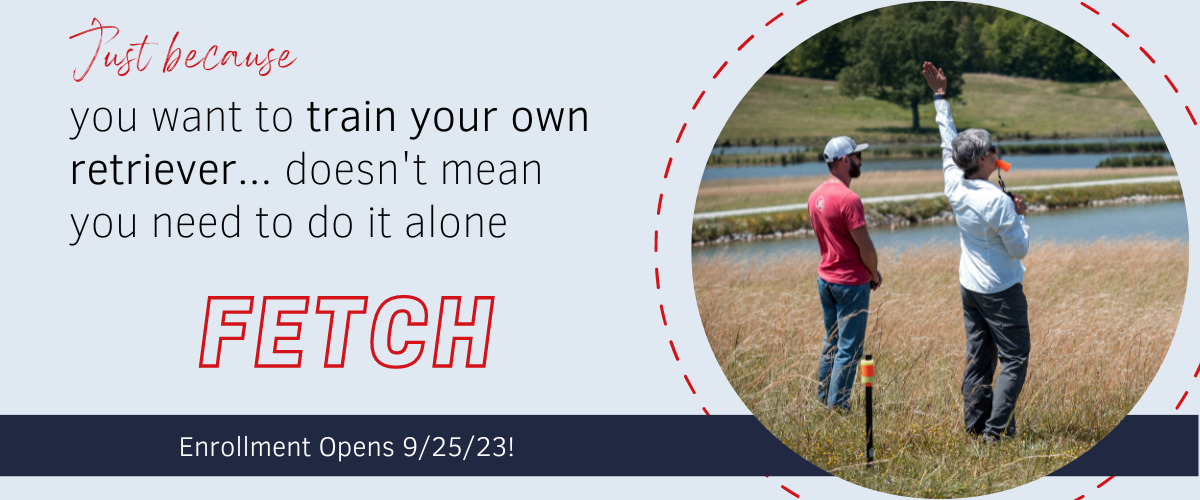FACT... Conventional Training Methods Are Causing Some Dogs To “Wash Out” Unnecessarily
Have you ever been told “Your dog just doesn’t have what it takes” or “Your dog is too sensitive”? What if the reason your dog got to this point was the WRONG training approach?
Over the past 28 years, I’ve trained hundreds of dogs using conventional methods. And while those methods worked well for many, there were still some problems. Dogs that clearly had the potential to be really good, didn’t make it.
I remember one in particular, a black lab named Taco. He loved to retrieve, had great marking talent, and was smarter than the average dog. His basics were going okay…that is until force to the pile. I remember vividly how his attitude changed during that time. He became demotivated, disinterested in certain types of work, and came to resent training in some ways. Unfortunately, his attitude never recovered, and eventually, the owner and I made the difficult decision to wash him out. Looking back, I can honestly say that if I’d done things a little differently, I wouldn’t be telling you his story today.
Outcomes like these aren’t all that uncommon. So let me ask you, is it possible that we’re so focused on the process, that we’re losing sight of the outcome?
Let's review a few things to try and figure out how WE can do better:
First, let's talk about the science of retriever training. As trainers, it's our responsibility to evaluate our methods continually, and ask ourselves…
Why did my dog struggle to figure it out? Why were the results poor? Why did my dog’s attitude decline? What skill or knowledge am I trying to teach? Is the information clear? Are there enough steps? Would a different approach achieve similar goals yet result in better outcomes?
These are questions that I’m ALWAYS asking and striving to answer. I want my dogs to easily understand what I’m trying to teach, to feel that I’m being fair, to work enthusiastically, to try to meet standards, and I want them to be prepared for the steps to come.
Second, the methods that served me 20 years ago, still serve many trainers today. But over time, it’s become clear to me that there are many shortcomings in our programs. For instance
- Ear Pinch at a minimum is awkward and can be gruesome
- Sit To The Pile doesn’t do enough to avoid loopy sits
- Force To The Pile is technically flawed and unfairly punishes dogs that are trying.
- Furthermore, there isn’t enough drill work to adequately prepare dogs for cold blinds and swim-by
Some might say these are bold statements. But are they?
Let's take a minute to look at how you can evaluate and adjust your training approaches. The first and most important question you should ask is “What am I trying to accomplish by doing this drill, what are the objectives?”. If you don’t know exactly why you’re doing something, how can you be sure that you’re going to get where you need to be? When you consider what you’re trying to accomplish, how you look at the drill and what you think is important might change.
It’s not as simple as stating the goal of the drill, but you should identify:
- Each skill you're trying to teach
- Each standard you’re trying to set
- The quality of the work you desire
If you don’t know what the answers are to these questions, then get help. Talk to people you trust, ask questions, and watch videos or read articles from trusted sources.
So now that you’re training with the outcome in mind, it's time to get practical, to get out to the field and train. But is that all you need to do?? Absolutely not. You must constantly evaluate what's happening and listen to your gut instincts. For someone who has little experience, this can be difficult to do on the fly. One helpful solution is to mount your phone on a tripod and record your training session so that you can play the tape back later. This will give you another valuable opportunity to see what’s happening. When you’re not getting the results you think you should be seeing, or your dog’s attitude is in decline, or the training seems to be going sideways, or new problems are developing, it’s time to ask yourself WHY? Figuring out the why is a crucial step in the process of developing better training approaches. If you’re not sure why, then seek out more help.
Now that you know the answers to two very important questions, “What am I trying to accomplish?” and “What’s causing the problems?” you can move on to the final question. And that is “How can I modify the training to improve the outcomes?”
In my next video, I'm going to talk specifically about the T and take you through this analytical process in real-time. I’ll identify some of the shortcomings and the problems it currently presents. I’ll talk about things we can do differently to achieve better outcomes and higher standards. I’ll show you where opportunities exist to teach different skills and prepare your dog with the knowledge they need to run cold blinds and handle in the field. If you want to learn more, be sure to watch it when it drops next week.

